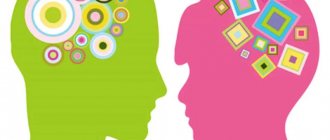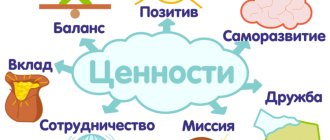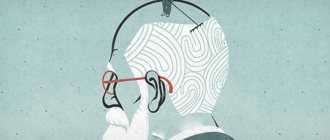Psychoanalysis is a methodology based on the study, identification, and analysis of an individual’s repressed, hidden or suppressed anxieties that have clearly traumatized his psyche.
The term psychoanalysis in psychology was first introduced by Sigmund Freud, who worked on the study of unconscious processes occurring in the human psyche and motivations deeply hidden in the human subconscious.
Based on the fundamentals of the methodology, human nature is viewed from the point of view of the confrontation of antipodal tendencies. It is psychoanalysis that makes it possible to see how unconscious confrontation affects not only personal self-esteem, but also the emotionality of the individual, his connections with his immediate environment, and individual social institutions.
Usually the source of conflict is localized in the conditions of the individual's experience, and since people are both social and biological beings, their main biological aspiration is the search for pleasure while simultaneously avoiding any form of pain.
A closer look at the theory of psychoanalysis reveals the presence of three elementary, interdependent and mutually reinforcing parts: conscious, preconscious and unconscious.
It is in the preconscious that a significant number of the individual’s fantasy impulses and desires are concentrated. Moreover, if you focus enough on the goal, then it is quite possible to redirect such desires into the conscious. Those events that, due to the existing moral guidelines of the individual, are denied by him as acceptable, and perhaps are regarded as painful and therefore move to the unconscious part.
It is this part of the acquired experience that turns out to be separated from the other two by a wall, and therefore it is useful to understand that psychoanalysis is precisely concentrated on the study of the existing relationships between the parts of the conscious and unconscious.
It is worth noting that psychoanalysis in psychology operates with deep analytical mechanisms, such as:
- study of spontaneous actions performed in everyday life;
- research using independent associations through dream interpretation.
Features of psychoanalysis, differences between the direction and other movements in psychology
The concept of “psychoanalysis” was introduced into scientific psychological discourse by Sigmund Freud. He used it to define a new technique developed during research into mental disorders. According to Freud's theory, the psyche consists of a conscious part, a hidden and censoring layer. The preconscious does not allow a person’s hidden passions and desires to penetrate consciousness. To release them and rid the patient of contradictions, Freud came up with several ways to extract hidden information from the subconscious. He called the set of techniques the psychoanalytic method.
Subsequently, Freud's research was studied and developed by many psychoanalysts, in particular, his daughter Anna Freud. Their goal was to search for the relationship between the conscious and unconscious parts of the psyche. It is through this connection that information is transferred. Mental disorders are caused by conflicts between the conscious and subconscious. Man, being at the same time a biological and social being, is forced to constantly seek a compromise between his desires and socially acceptable behavior. The psychotherapist’s task is to find the cause of the conflict and help the patient resolve it in an accessible way.
In addition to psychoanalysis, to make a correct diagnosis, psychologists work in several areas:
- emotional;
- motivational;
- sensory images;
- relationship with reality.
Psychoanalysts consider only the personal data of the individual, and this makes it much more difficult to find the true cause of the disease, limiting the psychologist’s tools.
Concept of psychoanalysis
Definition 1
Psychoanalysis is a technique for studying processes occurring in the soul that cannot be studied in other ways.
The concept of psychoanalysis was introduced into psychology by Sigmund Freud, who believed that the unconscious content remains as such only with a constant and significant expenditure of libido energy. When content becomes accessible, energy is freed up, which the ego can use for more beneficial aspirations of the individual. Releasing blocked content helps minimize self-destruction. The need for punishment or feelings of inferiority can be overestimated through awareness of early events and fantasies that led to such a need. As a result of this, a person is freed from the suffering that he constantly causes to himself.
Note 1
The main categories of psychoanalysis: conscious, unconscious and preconscious. The conscious is a small part of the psyche. The unconscious and preconscious are the less studied and disclosed components of consciousness. A mental process is unconscious if its existence can be concluded only from the results of its influence. The preconscious is the part of the unconscious that contains accessible memories.
Finished works on a similar topic
- Course work Psychoanalysis in psychology 480 rub.
- Abstract Psychoanalysis in psychology 280 rub.
- Test paper Psychoanalysis in psychology 200 rub.
Receive completed work or specialist advice on your educational project Find out the cost
According to the theory of psychoanalysis, achieving agreement with the requirements of ID is possible, but quite difficult. Psychoanalysis strives to overcome natural resistance and return painful, repressed thoughts and memories from the ID zone to the conscious area. Freed from the repressive influences of the unconscious, the human ego strives to establish new heights of satisfaction in all areas of activity.
Jung's theory of the collective unconscious
The subject of Jung's research was the structure of the unconscious psyche. He believed that the individual does not fill the psyche with repressed desires, but receives images accumulated by his distant ancestors. Thus, his unconscious is a storehouse in which not only individual, but also collective information is stored, and the personality cannot be considered in isolation from them.
Jung separated the personal and the collective, highlighting the first in the upper, more conscious layer of the psyche. It includes personal memories, forgotten desires, experiences associated with individual experience. The filling of the personal unconscious depends on the social conditions of a person, his personal history.
The collective goes deep into the unconscious layer of the psyche. It includes instincts, natural knowledge, drives and archetypes. All knowledge received by people from animals, racial and religious prejudices become an inheritance and pass into the unconscious of every person, regardless of his local culture.
Accumulated archetypes and instincts determine human behavior and its internal content. Jung believed that there are only two human types: extroverted and introverted. The first is directed to the external environment. Such a person needs regular contact with other people; he can receive an energy charge only during communication. The second is directed inward. Introverted people need frequent solitude; they are absorbed in their own experiences and thoughts. Pure types are rare; most people are a mixture of the two types, leaning only slightly towards one of the polarities.
Jung also revised Freud's understanding of the term “libido.” He defined it as attraction, but did not identify it only with the sexual instinct.
Psychoanalysis in brief
Within the framework of psychoanalysis, attention is paid to the unconscious processes of the psyche and human motives. At the same time, the basis is a conflict between consciousness and situations repressed into the unconscious.
The main reason for this process is the influence of society. Man, as a biological object, desires pleasure and avoids pain. But he is subject to the rules established in society. They are fixed in consciousness. At the same time, desires are censored and, as unwanted, are repressed into the unconscious. This happens with all a person’s desires, which he does not allow to think about due to attitudes or prohibitions formulated by the external environment.
Adler's theory of the need for compensation
Considering the process of personality formation, Adler named a feeling of inferiority as a driving motive. The most common cause of disability is physical disabilities. An individual, realizing his difference from other people, strives to regain a sense of fullness and take a more advantageous position in society.
To do this, he uses compensation, realizing himself in other areas not related to the defective one. The inability to receive compensation causes neurosis.
Adler denied Freud's assertions about the susceptibility of human behavior to instincts and drives. In his opinion, the main incentive of an individual is the desire to communicate, to realize oneself as a member of society. The life of an individual is determined by his orientation towards other subjects, and not by his innate qualities.
Psychoanalysis as one of the directions in psychology
Psychoanalysis is one of the directions in psychology, founded by the Austrian psychiatrist and psychologist S. Freud at the end of the 19th - first third of the 20th centuries.
This psychological direction is based on the concept of the unconscious by S. Freud. The impetus for a deep study of the unconscious was for Freud his presence at a hypnosis session, when a suggestion was made to a patient in a hypnotic state, according to which, after waking up, she had to get up and take an umbrella standing in the corner and belonging to one of those present. Before awakening, she was instructed to forget that this suggestion had been carried out. After waking up, the patient got up, walked over and took the umbrella, and then opened it. When asked why she did this, she replied that she wanted to check whether the umbrella was working or not. When they noticed that the umbrella was not hers, she was extremely embarrassed.
This experiment attracted the attention of Freud, who became interested in a number of phenomena. Firstly, the lack of awareness of the reasons for the actions taken. Secondly, the absolute effectiveness of these reasons: a person performs a task, despite the fact that he himself does not know why he is doing it. Thirdly, the desire to find an explanation for one’s action. Fourthly, it is sometimes possible, through lengthy questioning, to lead a person to remember the true reason for his action. Thanks to this incident and relying on a number of other facts, Freud created his theory of the unconscious.
According to Freud's theory, there are three spheres or regions in the human psyche: consciousness, preconscious and unconscious. He classified everything that is conscious and controlled by a person into the category of consciousness. Freud referred to the area of preconsciousness as hidden, or latent, knowledge. This is the knowledge that a person has, but which is currently absent from consciousness. They are initiated when a corresponding stimulus occurs.
The area of the unconscious, according to Freud, has completely different properties. The first property is that the content of this area is not conscious, but has an extremely significant influence on our behavior. The area of the unconscious is active. The second property is that information located in the unconscious area hardly passes into consciousness. This is explained by the work of two mechanisms: repression and resistance.
In his theory, Freud identified three main forms of manifestation of the unconscious: dreams, erroneous actions, and neurotic symptoms. To study the manifestations of the unconscious within the framework of the theory of psychoanalysis, methods for studying them were developed - the method of free associations and the method of dream analysis. The free association method involves the psychoanalyst interpreting the words continuously produced by the patient. The psychoanalyst must find a pattern in the words produced by the patient and make an appropriate conclusion about the causes of the condition that arose in the person seeking help. As one of the variants of this method in psychoanalysis, an association experiment is used, when the patient is asked to quickly and without hesitation name words in response to a word spoken by the psychoanalyst. As a rule, after several dozen trials, words associated with his hidden experiences begin to appear in the test subject’s answers.
Dream analysis is carried out in a similar way. The need to analyze dreams, according to Freud, is due to the fact that during sleep the level of control of consciousness decreases and a person experiences dreams caused by a partial breakthrough into the sphere of consciousness of his drives, which are blocked by consciousness in the waking state.
Freud paid special attention to neurotic symptoms. According to his ideas, neurotic symptoms are traces of repressed traumatic circumstances that form a highly charged focus in the unconscious and from there carry out destructive work to destabilize a person’s mental state. In order to get rid of neurotic symptoms, Freud considered it necessary to open this focus, that is, to make the patient aware of the reasons behind his condition, and then the neurosis will be cured.
Freud considered the basis for the emergence of neurotic symptoms to be the most important biological need of all living organisms - the need for procreation, which manifests itself in humans in the form of sexual desire. Suppressed sexual desire is the cause of neurotic disorders. However, such disorders can also be caused by other reasons not related to a person’s sexuality. These are a variety of unpleasant experiences that accompany everyday life. As a result of being repressed into the sphere of the unconscious, they also form strong energy foci, which manifest themselves in so-called erroneous actions. Freud considered forgetting certain facts, intentions, names, as well as slips of the tongue, slips of the tongue, etc. to be erroneous actions. These phenomena were explained by him as a consequence of difficult or unpleasant experiences associated with a particular object, word, name, etc. , slips of the tongue or accidental slips, Freud explained by the fact that they contain a person’s true intentions, carefully hidden from others.
The formation of S. Freud's views went through two main stages. At the 1st stage, a dynamic model of the psyche was developed, including an idea of its three spheres: consciousness, preconscious and unconscious. At the 2nd stage (starting from the 1920s), psychoanalysis turns into a doctrine of personality, in which three structures are distinguished: It (Id), I (Ego) and Super-I (Super-Ego). Structure It contains innate unconscious instincts (the instinct of life and death), as well as repressed drives and desires. The structure of the ego is formed under the influence of the external world and is under the bilateral influence of the id and the superego. The structure of the Super-Ego contains a system of ideals, norms and prohibitions, and is formed in individual experience through identification with the Super-Ego of parents and close adults. The struggle between the structures of the Super-I and the Id gives rise to unconscious defense mechanisms of the personality, as well as the sublimation of unconscious drives.
However, very few of S. Freud's followers agreed with him that sexual desires determine a person's entire life. This direction was further developed in the works of A. Adler, K. Jung, E. Erikson, K. Horney, A. Assogioli, E. Fromm and others.
Thus, A. Adler creates his own version of psychoanalysis - individual psychology, in which the central place is given to the problems of target determination of human behavior, the meaning of life, the conditions for the emergence of an inferiority complex in an individual and means of compensation (overcompensation) for real and imaginary shortcomings.
E. Erikson, using a large amount of empirical material, proved the sociocultural conditioning of the human psyche, as opposed to classical psychoanalysis, where man and society were opposed. The most important concept in E. Erikson’s concept is the concept of “psychosocial identity”: a stable image of the self and corresponding modes of behavior of the individual, which are developed throughout life and are a condition of mental health. But with significant social upheavals (war, disasters, violence, unemployment, etc.), psychosocial identity may be lost. The main role in the formation of this personal formation is played by the I (Ego), which is oriented towards the values and ideals of society, which in the process of educating the individual become the values and ideals of the individual.
K. Jung, one of Z. Freud's students, created his own version of psychoanalysis - analytical psychology. Based on the analysis of dreams, delusions, schizophrenic disorders, as well as on studies of mythology, works of oriental, ancient and medieval philosophers, K. Jung comes to the conclusion about the existence and manifestation of the collective unconscious in human psychology. According to K. Jung, the contents of the collective unconscious are not acquired in the individual life experience of the subject - they already exist at birth in the form of archetypes that are inherited from ancestors.
And according to K. Horney, neuroses develop due to contradictions in people’s relationships, which actualize a person’s feeling of “fundamental anxiety.” Relationships with parents in childhood play a particularly important role in the neurotic development of personality.
Berne's psychoanalytic transaction theory
While studying Freud's theory of psychoanalysis, Berne developed his own theory based on several types of social games. By games, Berne understood the interaction options used by individuals in everyday communication. He called the method of transmitting information “transaction”. When taking on one of the social roles, a person uses the appropriate type of transaction, allowing the interlocutor to choose his own option for interaction.
A person is always in one of 3 states: adult, child or parent. The dynamics of the psyche depend on the chosen state, directing human behavior. Unlike other psychoanalysts, Berne viewed personality in the context of the life history of ancestors. He believed that behavior patterns are inherited or formed under the influence of parents
The idea, goals and objectives of the psychoanalytic direction
Psychoanalysis in psychotherapy is a means of obtaining complete information about the client. The main tasks of psychoanalysis:
- Collection of necessary information about the client. Psychoanalysis allows you to collect raw data. Unlike questionnaires and other methods that involve choosing from several answer options, psychoanalytic methods do not limit the client.
- Establishing the true cause of psychopathology. The deeper the roots of the problem, the more difficult it is to determine the root cause. Psychoanalysis allows you to view all the data inherent in a person, even those determined genetically.
- Elimination of internal conflict of contradictions. Psychoanalysis, releasing repressed desires, simultaneously relieves the client of accumulated tension caused by the constant need to fight them.
The idea of psychoanalysis, as a separate direction, is subject to the general concept of motivation for human behavior. According to psychologists, the true motives of behavior are hidden and often incomprehensible to the person himself.
Selected areas, methods of application in psychology
In modern psychoanalytic practice, classical treatment methods are used not only to treat neurosis, but also to study the causes of many other diseases.
Certain techniques of psychoanalysis are used to diagnose and alleviate the client’s condition with depression, bipolar disorder, dissociation, as well as to solve problems at the client’s personal request.
Neo-Freudianism and structural psychoanalysis are considered the most promising directions in psychoanalysis. Followers of Freud's theory, taking his work as a basis, tried to revise them in order to bring the idea of the unconscious closer to the social rather than the biological component. Jung was skeptical about the role of the unconscious, considering the main driving force of personality structure to be skills acquired in society. In structural psychoanalysis, semantic features of speech are used to study the unconscious: clients with different life experiences assign different meanings to the same terms.
Followers of Freud's philosophy did not always accept his concept completely, trying to introduce personal ideas into it. But, regardless of the author’s modification, all concepts based on psychoanalysis include the doctrine of the conscious and unconscious.
Modern psychoanalysis
The basis of psychoanalysis remains the teachings of Sigmund Freud. His ideas about the unconscious give science a large area to study.
In the 21st century, psychoanalysis is developing in three directions:
- A psychoanalytic concept on the basis of which a direction changes its boundaries and is filled with new ideas.
- Applied psychoanalysis, which studies the manifestations of society: culture, values and social needs.
- Clinical psychoanalysis. This is a whole therapeutic method for working with clients. In therapy, the client is placed lying down on a couch and the therapist sits at the head of the bed. At the same time, the client does not see the therapist. This helps his thoughts flow freely. He gets the impression that he is having a dialogue with himself. This atmosphere allows the client to relax.
The creation of psychoanalysis as a branch of science was an important milestone in the development of psychology. Within the framework of this teaching, features of the psyche were touched upon, which help to understand the source and mechanism of a person’s internal problems. With the development of psychoanalysis, it became possible to work not only with the information that the client gives, but also to reach the depth of his unconscious thoughts.
Stages of mental analysis, psychoanalyst tools
In psychoanalysis, they use step-by-step work with a person, consisting of 3 steps:
- Production of material. At this stage, the psychoanalyst collects information without attempting to evaluate or filter. It is important to obtain full disclosure from the client in order to collect truthful data.
- Information analysis. The collected material is considered from the point of view of professional knowledge, and a model of working with the client is selected.
- Working alliance with the client. A working relationship is established with the client, in which the psychologist plays a guiding role.
To collect information in psychotherapy, methods are used to obtain true data. These methods include:
- Interpretation of dreams. The client keeps a dream diary, where he writes down every day all the dreams that he can remember. The psychologist uses the recordings for further interpretation.
- Speaking out thoughts. The client speaks out all his thoughts for a given time, without trying to think about his speech. The psychotherapist records information on a voice recorder without commenting on what he heard in front of the client.
- Free associations. A classic method developed by Freud and used by him to characterize a client's internal states. It involves the use of associative thinking. The client hears a series of unrelated words, naming the first association for each one. Based on the data obtained, assumptions are made about a person’s real motives. It is important that the associations come first; the client should not think and try to guess which association will be preferable.
The reliability of the information received depends on the degree of trust between the psychotherapist and the client. The correct type of relationship is established if the phenomenon of transference occurs: the client sees the therapist as a parental figure and transfers onto him the feelings and desires experienced in early childhood.
The use of psychoanalysis in psychology
The method of psychoanalysis is based on three main elements, which fully reveal the entire concept of this teaching . The first element is a kind of stage at which material for study is collected. The second element involves careful study and analysis of the data obtained. The third element is interaction using data obtained as a result of analysis. Various techniques are used to collect information, including the method of confrontation, association and transference.
The method of building free associations is based on creating a model of situations that exactly repeat certain life events. This approach allows us to identify certain processes occurring at the unconscious level of the psyche. The use of this method makes it possible to obtain data on pathological processes for the purpose of further correction of mental disorders. Correction is carried out through awareness of internal conflicts and the causes of their occurrence. One of the important conditions for using this method is the creation of a strong communicative connection between the psychologist and the patient, aimed at eliminating psychological discomfort.
Psychoanalysis studies the internal, emanating from the subconscious, driven by instincts and the principle of pleasure, human tension
To do this, the patient must voice every thought that arises in his head. These thoughts may be obscene or borderline absurd. In order to achieve a high result, it is necessary to create the right connection between the doctor and the patient. The transference technique involves the unconscious transfer of the characteristic personality traits of the patient’s parents to the attending physician. Thus, the patient treats the doctor in the same way as he treated close relatives in early childhood. At the same time, the substitute person gets the opportunity to identify childhood desires, grievances and psychological trauma received during the formation of personality.
It is important to pay attention to the fact that psychotherapeutic intervention often encounters the phenomenon of internal resistance emanating from the patient. It manifests itself in the form of a refusal to comprehend cause-and-effect relationships and a disruption in the process of creating a new model of behavior. The reason for resistance is an unconscious refusal to deal with internal conflicts, which is accompanied by the appearance of obstacles to identifying the causes of mental disorders.
The main task of personality analysis is to perform four sequential actions:
- interpretation;
- working off;
- clarification;
- opposition.
Further, the joint efforts of the patient and the psychologist are directed towards achieving a specific goal, which was identified as a result of the analysis. The technique of dream interpretation involves the interpretation of dreams, which are a deformed form of unconscious motives.
The influence of Z. Freud on the development of the psychoanalytic approach
Psychoanalysis according to Sigmund Freud is based on the idea of consciousness as the main mechanism regulating behavior. Studying the nature of neuroses, Freud found out that in addition to consciousness, a person has a hidden, unconscious side of his personality, which stores desires, aspirations and motives. Suppression of desires caused such strong hidden feelings that many people developed neuroses and other mental disorders because of them. Having established the truth of the cause of the diseases, Freud began to look for a way to get rid of them. This is how his author’s theory of the healing method appeared - psychoanalysis.
Freud's philosophy of psychoanalysis is based on several components:
- unconscious mental processes;
- Oedipus complex;
- the doctrine of resistance and suppression;
- sexual development.
According to the psychoanalyst, a doctor cannot diagnose a patient if he is not familiar with the psychoanalytic framework.
Freud's psychoanalysis gave psychology several basic concepts. These include “libido” - unconscious sexual desire. The psychoanalyst viewed any creative aspiration as the realization of inaccessible sexual desires. Creativity reflected the true desires of the individual, helping to relieve emotional stress. Also in Freud's works, a description of destructive processes appeared for the first time. Their development provokes a conflict between “Thanatos” and “Eros”, antagonistic driving forces symbolizing fundamental concepts (love and hate, life and death, need and rejection).
Psychoanalysis studies the motives of a person’s actions, the true reasons for which are inaccessible to him. Freud revealed that every personality strives for destructiveness, and only external social influence prompts him to choose approved behavior. People with a low level of self-regulation are not able to resist the secret desires of the subconscious. Destructive behavior becomes the norm for them.
Freud's theory of psychoanalysis even calls into question the rationality of thinking. Officially, in science, rationality was perceived as the main value and basic human aspiration. But Freud suggested that the mind does not always give the individual what he really wants. It is possible that rational thoughts are just an attempt by the subconscious to mask real desires and feelings, making them more acceptable. When treating neuroses, Freud believed it was necessary to allow the patient to release these desires.
The treatment process was simple: the patient, lying on a comfortable sofa, had to say everything that came to his mind. The main thing is not to try to control speech by voicing the first version of the thought, even if it sounds absurd. Freud sat next to the patient during the session and wrote down everything he said. Then, based on the processed information, he made assumptions about hidden desires and forgotten memories.
Freud also worked with dreams to study the subconscious. In his opinion, sleep is an attempt by the subconscious to break through the veil of social prohibitions and convey to a person a suppressed desire. The more complex and confusing the dream, the more significant it is for the patient. In psychoanalysis this is called resistance: the subconscious seeks to break a person’s will by giving him hidden symbols. Analysis of symbols allows us to understand the hidden content of a dream and relieve a person of internal tension.
A special place in Freud's theory of psychoanalysis was occupied by fears and the anxiety caused by them. His concept distinguishes 3 types of anxiety:
- realistic;
- neurotic;
- moral.
Each form of anxiety is a defensive reaction that warns of danger, allowing you to prepare in time for a threat. The internal conflict is resolved through a distortion of objective reality and a change in attitude towards the threat.
Methods of psychoanalysis
Let us consider in detail the main methods used in the field of psychoanalysis: the method of dream interpretation, the method of free association, the method of interpretation. Let's describe each one separately.
Free association method
What is this famous method based on? On the use of the phenomenon of associative thinking in order to study deep mental phenomena and processes (often they are unconscious). The data obtained are used for the treatment and correction of functional mental disorders, with the help of the patient’s awareness of the nature and source of the problems.
What is special about the free association method? In a conscious joint and purposeful confrontation between the therapist and the patient with a state of psychological discomfort. Acting together, the psychoanalyst and the patient cope with the problem.
The method of free association can be called a method for studying the mental state of a patient. He talks about any thoughts that come into his head, no matter how absurd or inappropriate they may seem. They may sound fantastic, ordinary, obscene. The therapist has to draw a conclusion from these revelations or incoherent fragments of thoughts.
In the “Dictionary of Psychoanalysis” (J.B. Pontalis, J. Laplanche) it is noted that free associations can be called the expression of all indiscriminately ideas and thoughts that arise in the mind - spontaneously or starting from any element (number, word, image from a dream).
Freud called for abandoning the role of controlled consciousness, beginning to understand mental processes. He stated that consciousness tries to eliminate images and thoughts that appear on the periphery before the attention of the analyzing object is focused on them. Moreover, when analyzing the mental state, it is these images and thoughts that can carry special meaning.
It was Freud who first began to actively use the method of free association. The psychoanalyst suggested that his patients lie down on the couch and relax, simply saying whatever came to their mind, no matter how incredible, absurd and unusual these thoughts were from the point of view of usual moral standards. During the sessions, the therapist observed how powerful emotional drives led uncontrolled thinking to mental conflict. The famous psychotherapist stated that the first random image and thought implies exactly what is needed for psychoanalysis. A random thought may have a connection to a repressed memory.
Dream interpretation method
According to the theories of Sigmund Freud, dreams can reveal the presence of intense mental activity in the depths of consciousness. What is dream analysis? The therapist must find the distorted unconscious truth hidden in every dream. Freud was convinced: the stranger and more confusing the dream, the more hidden content it contains. In the language of psychoanalysis, this phenomenon is called resistance - its manifestations can be noticed even when the person who saw the dream does not agree to its interpretation. This speaks of his unconscious resistance, established barriers to protect his own psyche.
Dreams separate the unconscious from the real world. In them, exciting situations that cause emotions are deformed in the most bizarre way. Dreams can also tell about secret desires. In the case of child psychoanalysis, the differences between hidden and overt thoughts are less clear.
Hidden thoughts are transformed into symbols, appearing in a form acceptable to consciousness. This allows them to bypass certain "censorship". Even today, the manifestation of the unconscious in the form of dreams remains one of the greatest mysteries of consciousness.
The method of dream interpretation is very important - it allows you to identify the essence of the images that appear in a dream. Freud processed dreams by positioning them as symptoms of illness. According to him, for the correct use of this method, it is not recommended to consider dreams as something single - such an analysis will not lead to anything worthwhile. He was convinced: when analyzing dreams, it is necessary to painstakingly study its elements separately. The association rule should be applied to individual fragments. Freud considered any dream not only an object worthy of scientific research, but also a way to know one’s deep essence, to discover hidden desires that do not appear on the surface.
Interpretation method
Interpretation is considered one of the most important tools of any analyst. Even in the interpretation of dreams and free associations, interpretations are used by the therapist. What does this term mean?
Interpretation is called the main analytical tool. In dream interpretation and free association, the psychoanalyst attempts to use interpretations. We are talking about transferring significant information about the patient from the unconscious level to the conscious level. Repressing information that causes concern and anxiety in an individual, as well as its correct analysis, will soften the symptoms of neurosis or other mental problems.









